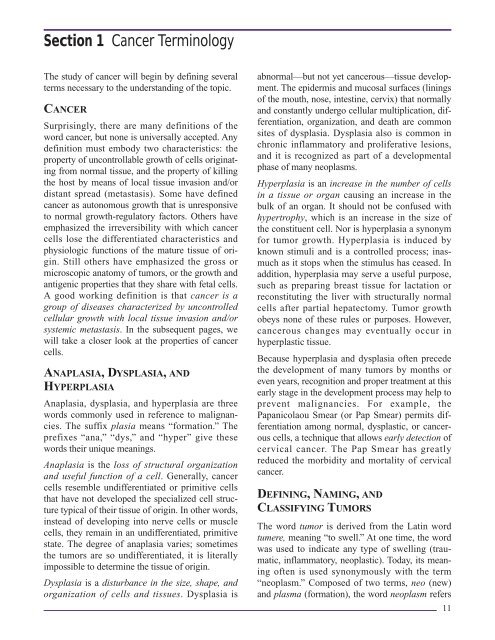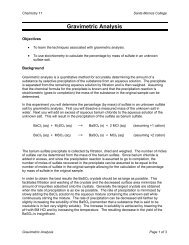Anaplasia/Dysplasia handout - read
Anaplasia/Dysplasia handout - read
Anaplasia/Dysplasia handout - read
You also want an ePaper? Increase the reach of your titles
YUMPU automatically turns print PDFs into web optimized ePapers that Google loves.
Section 1 Cancer Terminology<br />
The study of cancer will begin by defining several<br />
terms necessary to the understanding of the topic.<br />
CANCER<br />
Surprisingly, there are many definitions of the<br />
word cancer, but none is universally accepted. Any<br />
definition must embody two characteristics: the<br />
property of uncontrollable growth of cells originating<br />
from normal tissue, and the property of killing<br />
the host by means of local tissue invasion and/or<br />
distant sp<strong>read</strong> (metastasis). Some have defined<br />
cancer as autonomous growth that is unresponsive<br />
to normal growth-regulatory factors. Others have<br />
emphasized the irreversibility with which cancer<br />
cells lose the differentiated characteristics and<br />
physiologic functions of the mature tissue of origin.<br />
Still others have emphasized the gross or<br />
microscopic anatomy of tumors, or the growth and<br />
antigenic properties that they share with fetal cells.<br />
A good working definition is that cancer is a<br />
group of diseases characterized by uncontrolled<br />
cellular growth with local tissue invasion and/or<br />
systemic metastasis. In the subsequent pages, we<br />
will take a closer look at the properties of cancer<br />
cells.<br />
ANAPLASIA,DYSPLASIA, AND<br />
HYPERPLASIA<br />
<strong>Anaplasia</strong>, dysplasia, and hyperplasia are three<br />
words commonly used in reference to malignancies.<br />
The suffix plasia means “formation.” The<br />
prefixes “ana,” “dys,” and “hyper” give these<br />
words their unique meanings.<br />
<strong>Anaplasia</strong> is the loss of structural organization<br />
and useful function of a cell. Generally, cancer<br />
cells resemble undifferentiated or primitive cells<br />
that have not developed the specialized cell structure<br />
typical of their tissue of origin. In other words,<br />
instead of developing into nerve cells or muscle<br />
cells, they remain in an undifferentiated, primitive<br />
state. The degree of anaplasia varies; sometimes<br />
the tumors are so undifferentiated, it is literally<br />
impossible to determine the tissue of origin.<br />
<strong>Dysplasia</strong> is a disturbance in the size, shape, and<br />
organization of cells and tissues. <strong>Dysplasia</strong> is<br />
abnormal—but not yet cancerous—tissue development.<br />
The epidermis and mucosal surfaces (linings<br />
of the mouth, nose, intestine, cervix) that normally<br />
and constantly undergo cellular multiplication, differentiation,<br />
organization, and death are common<br />
sites of dysplasia. <strong>Dysplasia</strong> also is common in<br />
chronic inflammatory and proliferative lesions,<br />
and it is recognized as part of a developmental<br />
phase of many neoplasms.<br />
Hyperplasia is an increase in the number of cells<br />
in a tissue or organ causing an increase in the<br />
bulk of an organ. It should not be confused with<br />
hypertrophy, which is an increase in the size of<br />
the constituent cell. Nor is hyperplasia a synonym<br />
for tumor growth. Hyperplasia is induced by<br />
known stimuli and is a controlled process; inasmuch<br />
as it stops when the stimulus has ceased. In<br />
addition, hyperplasia may serve a useful purpose,<br />
such as preparing breast tissue for lactation or<br />
reconstituting the liver with structurally normal<br />
cells after partial hepatectomy. Tumor growth<br />
obeys none of these rules or purposes. However,<br />
cancerous changes may eventually occur in<br />
hyperplastic tissue.<br />
Because hyperplasia and dysplasia often precede<br />
the development of many tumors by months or<br />
even years, recognition and proper treatment at this<br />
early stage in the development process may help to<br />
prevent malignancies. For example, the<br />
Papanicolaou Smear (or Pap Smear) permits differentiation<br />
among normal, dysplastic, or cancerous<br />
cells, a technique that allows early detection of<br />
cervical cancer. The Pap Smear has greatly<br />
reduced the morbidity and mortality of cervical<br />
cancer.<br />
DEFINING,NAMING, AND<br />
CLASSIFYING TUMORS<br />
The word tumor is derived from the Latin word<br />
tumere, meaning “to swell.” At one time, the word<br />
was used to indicate any type of swelling (traumatic,<br />
inflammatory, neoplastic). Today, its meaning<br />
often is used synonymously with the term<br />
“neoplasm.” Composed of two terms, neo (new)<br />
and plasma (formation), the word neoplasm refers<br />
11
















